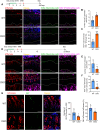Gli1 labels progenitors during chondrogenesis in postnatal mice
- PMID: 38409269
- PMCID: PMC11014955
- DOI: 10.1038/s44319-024-00093-x
Gli1 labels progenitors during chondrogenesis in postnatal mice
Abstract
Skeletal growth promoted by endochondral ossification is tightly coordinated by self-renewal and differentiation of chondrogenic progenitors. Emerging evidence has shown that multiple skeletal stem cells (SSCs) participate in cartilage formation. However, as yet, no study has reported the existence of common long-lasting chondrogenic progenitors in various types of cartilage. Here, we identify Gli1+ chondrogenic progenitors (Gli1+ CPs), which are distinct from PTHrP+ or FoxA2+ SSCs, are responsible for the lifelong generation of chondrocytes in the growth plate, vertebrae, ribs, and other cartilage. The absence of Gli1+ CPs leads to cartilage defects and dwarfishness phenotype in mice. Furthermore, we show that the BMP signal plays an important role in self-renewal and maintenance of Gli1+ CPs. Deletion of Bmpr1α triggers Gli1+ CPs quiescence exit and causes the exhaustion of Gli1+ CPs, consequently disrupting columnar cartilage. Collectively, our data demonstrate that Gli1+ CPs are common long-term chondrogenic progenitors in multiple types of cartilage and are essential to maintain cartilage homeostasis.
Keywords: BMP; Chondrogenic Progenitors; Gli1+ Cells; Hedgehog; Stem Cell Maintenance.
© 2024. The Author(s).
Conflict of interest statement
The authors declare no competing interests.
Figures











Similar articles
-
BMP2 induces chondrogenic differentiation, osteogenic differentiation and endochondral ossification in stem cells.Cell Tissue Res. 2016 Oct;366(1):101-11. doi: 10.1007/s00441-016-2403-0. Epub 2016 Apr 15. Cell Tissue Res. 2016. PMID: 27083447
-
Igf1 Regulates Fibrocartilage Stem Cells, Cartilage Growth, and Homeostasis in the Temporomandibular Joint of Mice.J Bone Miner Res. 2023 Apr;38(4):556-567. doi: 10.1002/jbmr.4782. Epub 2023 Feb 13. J Bone Miner Res. 2023. PMID: 36722289
-
Pth1r Signal in Gli1+ Cells Maintains Postnatal Cranial Base Synchondrosis.J Dent Res. 2023 Oct;102(11):1241-1251. doi: 10.1177/00220345231184405. Epub 2023 Aug 14. J Dent Res. 2023. PMID: 37575041
-
[Role and function regulation of transcription factors in endochondral ossification].Clin Calcium. 2012 May;22(5):643-52. Clin Calcium. 2012. PMID: 22549188 Review. Japanese.
-
[Molecular mechanisms of cartilage formation and chondrocyte maturation].Clin Calcium. 2004 Jul;14(7):15-21. Clin Calcium. 2004. PMID: 15577071 Review. Japanese.
Cited by
-
Key roles of the superficial zone in articular cartilage physiology, pathology, and regeneration.Chin Med J (Engl). 2025 Jun 20;138(12):1399-1410. doi: 10.1097/CM9.0000000000003319. Epub 2024 Oct 23. Chin Med J (Engl). 2025. PMID: 39439390 Free PMC article. Review.
-
β-catenin Orchestrates Gli1+ Cell Fate in Condylar Development and TMJOA.J Dent Res. 2024 Nov;103(12):1291-1301. doi: 10.1177/00220345241274354. Epub 2024 Oct 14. J Dent Res. 2024. PMID: 39400124
-
Identification of Postn+ periosteal progenitor cells with bone regenerative potential.JCI Insight. 2024 Oct 8;9(19):e182524. doi: 10.1172/jci.insight.182524. JCI Insight. 2024. PMID: 39377227 Free PMC article.
-
O-GlcNAcylation in Gli1+ Mesenchymal Stem Cells Is Indispensable for Bone Formation and Fracture Healing.Int J Mol Sci. 2025 Mar 18;26(6):2712. doi: 10.3390/ijms26062712. Int J Mol Sci. 2025. PMID: 40141354 Free PMC article.
References
-
- Andl T, Ahn K, Kairo A, Chu EY, Wine-Lee L, Reddy ST, Croft NJ, Cebra-Thomas JA, Metzger D, Chambon P, et al. Epithelial Bmpr1a regulates differentiation and proliferation in postnatal hair follicles and is essential for tooth development. Development. 2004;131:2257–2268. doi: 10.1242/dev.01125. - DOI - PubMed
-
- Chagin AS, Vuppalapati KK, Kobayashi T, Guo J, Hirai T, Chen M, Offermanns S, Weinstein LS, Kronenberg HM. G-protein stimulatory subunit alpha and Gq/11alpha G-proteins are both required to maintain quiescent stem-like chondrocytes. Nat Commun. 2014;5:3673. doi: 10.1038/ncomms4673. - DOI - PMC - PubMed
MeSH terms
Substances
Grants and funding
- 81825005/MOST | NSFC | National Science Fund for Distinguished Young Scholars (National Science Foundation for Distinguished Young Scholars)
- NSFC82071091/MOST | National Natural Science Foundation of China (NSFC)
- NSFC82001040/MOST | National Natural Science Foundation of China (NSFC)
- 2020M673265/China Postdoctoral Foundation Project | Postdoctoral Research Foundation of China (China Postdoctoral Research Foundation)
- 2023NSFSC0563/Sichuan Science and Technology Program
LinkOut - more resources
Full Text Sources
Molecular Biology Databases
Research Materials

